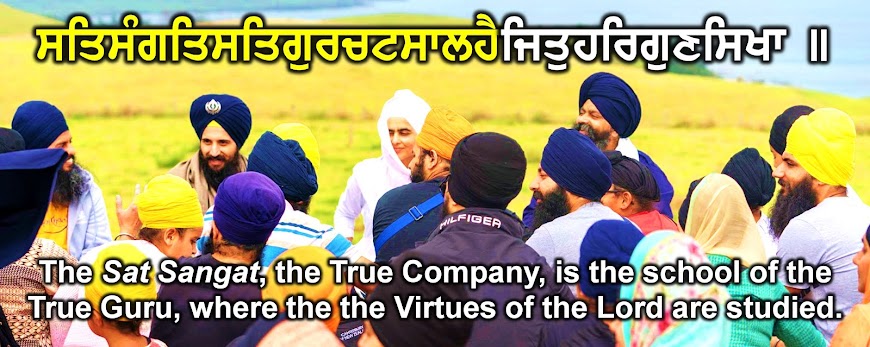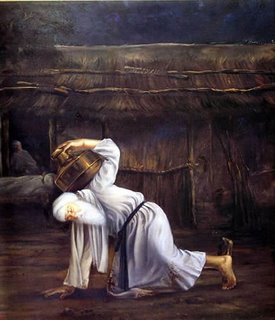ਭਲੇ ਅਮਰਦਾਸ ਗੁਣ ਤੇਰੇ ਤੇਰੀ ਉਪਮਾ ਤੋਹਿ ਬਨਿ ਆਵੈ ॥੧॥੨੨॥
bhale amardaas gun tere, teree upmaa tohi ban aavai.
"In the Bhalla family Guru Amar Daas jee has been revealed! Your Glorious Virtues cannot be described; You alone are like You."
(Ang 1396)
bhale amardaas gun tere, teree upmaa tohi ban aavai.
"In the Bhalla family Guru Amar Daas jee has been revealed! Your Glorious Virtues cannot be described; You alone are like You."
(Ang 1396)
Good wishes to everyone on the happy occasion of Guru Amar Daas jee's Parkaash Divas (birth day). May Satguru jee fill the home of our heart with Naam and Gurmat virtues.
A GLIMPSE AT THE LIFE OF GURU AMAR DAAS SAHIB JEE SAHIB
Background
Guru Amar Daas jee was born in the village Basarke, near Amritsar, on Vaisakh 24 in the year 1479. Guru jee was the eldest son of Sri Tej Bhaan jee who was a farmer and trader and Mata Lachhmee jee, his devoted mother. From a young age he was spiritual and in search of the Truth. Guru jee was married at the age of 28 to Mata Manshi jee and had two sons (Bhai Mohri jee and Bhai Mohan jee) and two daughters (Bibi Daanee jee and Bibi Bhaanee jee). The search for the truth led him to go on pilgrimages to places like Hardwar, the river Ganga and other shrines. However, he was never spiritually satisfied. Once on the way back from Hardwar, a Brahmin saw the bottom of the feet of Guru Amar Daas jee. Looking at the outline of the feet, he folded his hands and commented that "Maharaaj, in your holy feet is supreme status. Supreme status is only found in the feet of a Great Holy Being, in the feet of someone who is an Avtaar (incarnation of God)." Guru jee replied, "I am pilgrim in search of the Truth." Days, months and years passed and the search, thirst and pull towards the Truth increased.
The search ends
Eventually one day the search ended. Guru Amar Daas jee heard a Gurbani Shabad uttered through the sacred mouth of Guru Nanak Dev jee through Bibi Amro jee, who was the daughter in-law of Guru Amar Daas jee's younger brother and the daughter of Guru Angad Dev jee. The Shabad was:
Eventually one day the search ended. Guru Amar Daas jee heard a Gurbani Shabad uttered through the sacred mouth of Guru Nanak Dev jee through Bibi Amro jee, who was the daughter in-law of Guru Amar Daas jee's younger brother and the daughter of Guru Angad Dev jee. The Shabad was:
ਮੋਤੀ ਤ ਮੰਦਰ ਊਸਰਹਿ ਰਤਨੀ ਤ ਹੋਹਿ ਜੜਾਉ ||
ਕਸਤੂਰਿ ਕੁੰਗੂ ਅਗਰਿ ਚੰਦਨਿ ਲੀਪਿ ਆਵੈ ਚਾਉ ||
ਮਤੁ ਦੇਖਿ ਭੂਲਾ ਵੀਸਰੈ ਤੇਰਾ ਚਿਤਿ ਨ ਆਵੈ ਨਾਉ ||੧||
ਹਰਿ ਬਿਨੁ ਜੀਉ ਜਲਿ ਬਲਿ ਜਾਉ ||
ਮੈ ਆਪਣਾ ਗੁਰੁ ਪੂਛਿ ਦੇਖਿਆ ਅਵਰੁ ਨਾਹੀ ਥਾਉ ||੧|| ਰਹਾਉ ||..."If I had a palace made of pearls, inlaid with jewels, scented with musk, saffron and sandalwood, a sheer delight to behold -seeing this, I might go astray and forget You, and Your Name would not enter into my mind. ||1|| Without the Lord, my soul is scorched and burnt. I consulted my Guru, and now I see that there is no other place at all. ||1||Pause||..."
(Ang 14 - Full Shabad)
He went to his daughter in-law and asked whose Bani (Sacred Words) are you reading? She replied, "Dear father, I am reading the revealed Words of Guru Nanak Dev jee. My father is their successor, the second Guru." Through Bibi Amro jee Guru Amar Daas jee was united with Guru Angad Dev jee. Despite being thirty years older and being father in-law of his daughter, Guru Amar Daas jee bowed to
Guru Angad Dev jee Sahib. This illustrated that age or relationship (ਰਿਸ਼ਤੇ) has no relevance in the relationship between Guru and the Sikh.
The Guru's tests
Just as Guru Nanak Dev jee tested the faith of Bhai Lehna jee who then became Guru Angad Dev jee, similarly Guru Angad Dev jee tested Guru Amar Daas jee. Guru Amar Daas jee would day and night immerse himself in Seva and Simran and personified Gurmat. In addition to Seva in the Guru's Kitchen, every Amrit-vela he would go to the River Beas and fill a container of water that Guru Angad Dev jee used to use to bathe with. One day, in the middle of the night, returning from River Beas with a container of water, he passed the house of a weaver. Outside the house his foot stumbled against a wooden peg that made him fall over into the pit of the weaver's loom. The weaver asked his wife, "Who is this in the middle of the night?" His wife said, "Don't worry in the middle of the night, it is Amroo Nithaanaa - Amroo the homeless one." Although he fell hard, he made sure the container of water never spilled over. The flowing endless river represents the Guru, and the container represents the body. Filling the container with water everyday, was not just filling water, but filling the body with the virtues of the Guru. Stumbling was the ups and downs of life and the world. Despite the world's ups and downs, he never allowed the Guru's virtues to escape or leave him.
Passing the test of Guruship
When this news reached Guru Angad Dev jee, he responded "Amar Dass jee
is not homeless, he the Home of the homeless, Shelter for the
shelterless and Helper of the helpless..." Guru Amar Daas Sahib jee served Guru Angad Dev jee with utmost devotion
and dedication. Besides fetching water from the River Beas, Guru jee would collect firewood for the Guru's Kitchen, serve Langar to the Sangat, clean the floor mats and carry water for Guru's Kitchen. Every year
Guru Angad Dev jee acknowledged his services by conferring upon him
a Siropa (a robe of honour) which the Great Guru wrapped around his
head. Guru Amar Daas jee was honoured with a Siropa seven times. Seva
(selfless service) is one of the main tenets of the House of Guru Nanak Dev jee , exemplified through the lives of the Gurus. Guru Amar Daas jee was the oldest aged Guru, illustrating that even the physically old can make change.
Responding to Hostility with Humility
Bhai Datu jee, son of Guru Angad Dev jee, considered himself to be the claimant of 'Gurgaddi' (the seat of Guruship), which he could not ascend to. Deeply frustrated, Bhai Datu jee kicked Guru Amar Daas jee with his foot while Guru jee was seated on the throne. With the display of sweetness and humility, Guru jee kept seated and did not utter a word of anger. Rather, he grabbed Bhai Datu jee’s foot and said, “Your foot must have been hurt by my hard bones.” Guru Sahib did not respond with a reaction rather through displaying his compassion. The Guru showed that each situation requires a unique response depending on the circumstances, and that replying to anger with compassion is a powerful weapon.
Bhai Datu jee, son of Guru Angad Dev jee, considered himself to be the claimant of 'Gurgaddi' (the seat of Guruship), which he could not ascend to. Deeply frustrated, Bhai Datu jee kicked Guru Amar Daas jee with his foot while Guru jee was seated on the throne. With the display of sweetness and humility, Guru jee kept seated and did not utter a word of anger. Rather, he grabbed Bhai Datu jee’s foot and said, “Your foot must have been hurt by my hard bones.” Guru Sahib did not respond with a reaction rather through displaying his compassion. The Guru showed that each situation requires a unique response depending on the circumstances, and that replying to anger with compassion is a powerful weapon.
Abolishing evil and cruel social practices
The reality of India at the time of the Guru Sahibs was that the author of Ramayan (Hindu mythological epic) had written that “The drum, Shudar (low caste) and woman are to beaten.” Guru Amar Daas jee rejected and abolished those cruel and evil social practices that Akbar's Mughal government could not abolish from society. The old age practices and traditions of Sati (women burnt in the funeral pyres of their husbands), Pardaah (women veiling their faces and women), the mistreatment of widows and child marriages were all successfully abolished by Guru jee. Guru Sahib taught that women are not a commodity and implemented social change and justice. Widows were not allowed to get married and were either forced into sexual exploitation or killed in the funeral pyres of their husbands. Guru jee promoted the re-marriages of widow men and women and made one single marriage ceremony (Anand Karaj) for first time marriages or re-marriages. Child marriages were prevalent in India at the time, which ruined a lot of young girls lives. Guru Amar Daas married his own daughter at the age of 18, to set a new example. The Mughal Emperor Akbar was so impressed by the social reforms that Guru jee brought to society that he personally came to visit Guru jee.
The reality of India at the time of the Guru Sahibs was that the author of Ramayan (Hindu mythological epic) had written that “The drum, Shudar (low caste) and woman are to beaten.” Guru Amar Daas jee rejected and abolished those cruel and evil social practices that Akbar's Mughal government could not abolish from society. The old age practices and traditions of Sati (women burnt in the funeral pyres of their husbands), Pardaah (women veiling their faces and women), the mistreatment of widows and child marriages were all successfully abolished by Guru jee. Guru Sahib taught that women are not a commodity and implemented social change and justice. Widows were not allowed to get married and were either forced into sexual exploitation or killed in the funeral pyres of their husbands. Guru jee promoted the re-marriages of widow men and women and made one single marriage ceremony (Anand Karaj) for first time marriages or re-marriages. Child marriages were prevalent in India at the time, which ruined a lot of young girls lives. Guru Amar Daas married his own daughter at the age of 18, to set a new example. The Mughal Emperor Akbar was so impressed by the social reforms that Guru jee brought to society that he personally came to visit Guru jee.

Establishment of Manjees
Guru Sahib politically developed the Sikh community. The Mughal Empire of Akbar was divided into 22 areas of rule. Guru Amar Daas jee deployed 22 chosen men and women into these 22 areas for preaching Gurbani and spreading the Guru's message. Four Sikh women were appointed as the religious heads of Sikh education centres. Districts under the charge of men were known as Manjeeaa(n), from manjee or string-bed. Those in the charge of women were known as PeeReeaa(n), which derives from peehee or sitting-stools on which they sat to minister to the disciples. Their selection for this important task indicated the faith of the Guru in the capacity of women for organisational work.
Guru Sahib politically developed the Sikh community. The Mughal Empire of Akbar was divided into 22 areas of rule. Guru Amar Daas jee deployed 22 chosen men and women into these 22 areas for preaching Gurbani and spreading the Guru's message. Four Sikh women were appointed as the religious heads of Sikh education centres. Districts under the charge of men were known as Manjeeaa(n), from manjee or string-bed. Those in the charge of women were known as PeeReeaa(n), which derives from peehee or sitting-stools on which they sat to minister to the disciples. Their selection for this important task indicated the faith of the Guru in the capacity of women for organisational work.
Construction of Goindwal Sahib
Guru Amar Daas jee followed the steps of the earlier Gurus in constructing cities. This was part of the vision of the Gurus to broaden the horizons of the Sikh People and show them that Sikhs should not confine themselves to thinking small but to think big. The Guru Sahibs were forward thinkers. Realising that the water of the River Beas was becoming not fit for human consumption, (which later become polluted) Guru Amar Daas Sahib jee constructed a Baoli (well) at Goindwal Sahib, covering the entire area with trees. This not only provided safe drinking water to the people but also helped to create an eco-friendly environment. Goindwal Sahib became a pilgrimage place for Sikhs and this is where Guru Amar Daas jee started the tradition of gathering Sikhs together on the day of Vaisakhi. Where people engaged in meaningless pilgrimages and bathed in rivers and lakes and got no spiritual gain, Guru Amar Daas jee made a pilgrimage place where you can physically bathe in water like but also spiritually bathe through reciting Gurbani, Simran and Seva.
Summary
Guru Amar Daas jee followed the steps of the earlier Gurus in constructing cities. This was part of the vision of the Gurus to broaden the horizons of the Sikh People and show them that Sikhs should not confine themselves to thinking small but to think big. The Guru Sahibs were forward thinkers. Realising that the water of the River Beas was becoming not fit for human consumption, (which later become polluted) Guru Amar Daas Sahib jee constructed a Baoli (well) at Goindwal Sahib, covering the entire area with trees. This not only provided safe drinking water to the people but also helped to create an eco-friendly environment. Goindwal Sahib became a pilgrimage place for Sikhs and this is where Guru Amar Daas jee started the tradition of gathering Sikhs together on the day of Vaisakhi. Where people engaged in meaningless pilgrimages and bathed in rivers and lakes and got no spiritual gain, Guru Amar Daas jee made a pilgrimage place where you can physically bathe in water like but also spiritually bathe through reciting Gurbani, Simran and Seva.
Summary
ਗੁਰ ਅਮਰਦਾਸ ਕੀ ਅਕਥ ਕਥਾ ਹੈ ਇਕ ਜੀਹ ਕਛੁ ਕਹੀ ਨ ਜਾਈ ॥
gur amardaas kee akath kathaa hai ik jeeh kachh kahee na jaa-ee.
"The Unspoken Speech of Guru Amar Daas Ji cannot be expressed with only one tongue."
(Ang 1406)
Bhai Nand Lal Singh Ji writes in his poetry that if one word could describe and summarise Guru Amar Daas Sahib Ji's life, that word be "EQUALITY."
Bhul Chuk Maaf.
DHAN GURU AMAR DAAS JEE.



.jpg)




























.JPG)
.JPG)





















